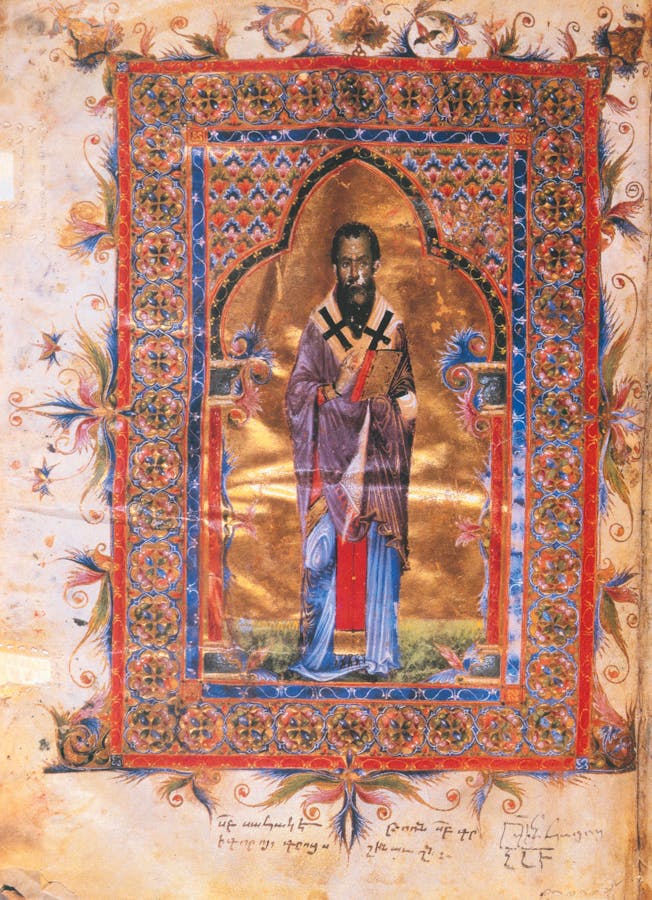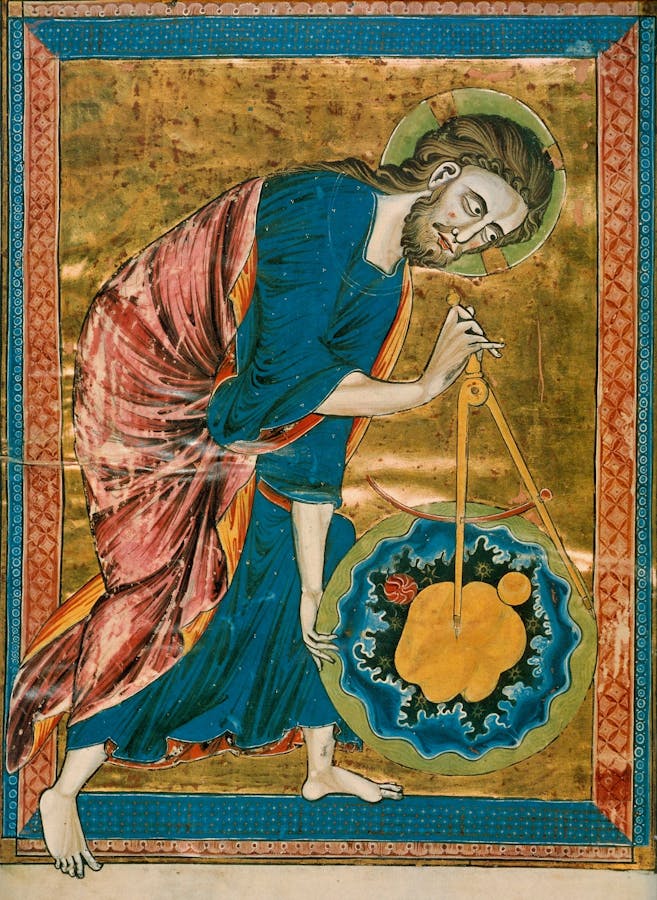How did biblical passages about creation influence the way ancient people viewed nature?
The Bible describes the creation of the cosmos differently than other ancient texts. For Jews and Christians in the Roman world, the biblical God was rational, not impulsive, and was not part of the created world. The world was created freely and purposefully, rather than by accident or necessity. God endowed creation with consistent laws and continues to uphold these processes.
These ideas framed how ancient Jews and Christians approached natural philosophy, as science was called at this time, and would fuel the desire to understand nature’s laws in the centuries that followed.
“Let us glorify the supreme Artificer for all that was wisely and skillfully made; by the beauty of visible things let us raise ourselves to Him who is above all beauty.”
Basil of Caesarea, Hexaemeron, Homily I, AD 378
For ancient Bible commentators, the topic of creation became an important juncture of scripture and scientific thought. Their studies often used natural philosophy to illuminate the biblical story and, in their minds, explore its meaning.
The biblical account led these authors to believe creation was no accident. God created the world according to a plan, which moved in a purposeful, linear direction. This orderly beginning revealed God’s care and wisdom and established a regularity in nature essential for scientific inquiry.
Similar works would flourish in the Middle Ages, encouraging people to explore the natural world, its origins, and its changes.

Narratives from the creation story in Genesis, such as this fresco of God creating the sun, moon, and stars on the fourth day, adorn the walls of the Monreale Cathedral in Sicily.
Unknown author. Public domain, via Wikimedia Commons

While most educated people in the ancient world knew the earth was round, not everybody held this view. Cosmos Indicopleustes was an Egyptian monk and world traveler whose Christian topography, a geography book, depicted a flat Earth.
Cosmas Indicopleustes, Public domain, via Wikimedia Commons

Moses Maimonides was a medieval Jewish philosopher and biblical commentator. Drawing from Philo of Alexandria and other sources, he sought to resolve any conflict between the biblical accounts and scientific philosophy of his day. This is a fragment of his work Guide for the Perplexed.
Courtesy of Museum of the Bible

Basil of Caesarea is depicted in this Armenian illuminated manuscript dating to 1286.
akg-images / WHA / World History Archive

This fifteenth-century fresco from the Church of the Ognissanti in Florence shows Church Father St. Augustine of Hippo writing in his study.
Sheila Terry / Science Photo Library
Biblical scholars of the classical Greco-Roman world, Philo of Alexandria, Basil of Caesarea, and Augustine of Hippo, each wrote commentaries on Genesis 1 that reveal ways ancient people engaged with scripture and scientific thought—and influenced many others later.
The belief that creation had a beginning put them at odds with some major schools of thought. It also helped encourage a sense of time and history as linear that would profoundly influence Western thought.
While the amount of our knowledge has grown, ancient peoples were just as clever and curious as people today. Educated Jews and Christians in the Roman period were schooled in Greek philosophy, the leading scientific thought of the day. They accepted that a spherical Earth sat at the center of the universe. Above Earth were the celestial spheres (the heavens), where the fixed stars (which make up the constellations) and wandering stars (planets) resided.
Philo of Alexandria was a first-century Jewish scholar who sought to defend the Genesis creation account against criticism from Greek philosophers. His writings compared God to an architect who crafted creation according to a plan. These metaphors would influence later biblical commentators.
Basil of Caesarea was a pastor and theologian. In his Hexaemeron, he made use of some elements of Aristotle’s biology, such as spontaneous generation, to explain parts of the living world. But he rejected Aristotle’s claims of an eternal universe, which Basil believed contradicted the Genesis account.
Augustine of Hippo was a pastor, theologian, and bishop. His work, The Literal Meaning of Genesis, argued that Genesis was written in the language and vocabulary of ordinary people so it would be understandable to them, rather than in scientifically accurate terms. This idea became standard in biblical scholarship and influenced many thinkers that followed, including Galileo.
For ancient Bible commentators, the topic of creation became an important juncture of scripture and scientific thought. Their studies often used natural philosophy to illuminate the biblical story and, in their minds, explore its meaning.
The biblical account led these authors to believe creation was no accident. God created the world according to a plan, which moved in a purposeful, linear direction. This orderly beginning revealed God’s care and wisdom and established a regularity in nature essential for scientific inquiry.
Similar works would flourish in the Middle Ages, encouraging people to explore the natural world, its origins, and its changes.

Narratives from the creation story in Genesis, such as this fresco of God creating the sun, moon, and stars on the fourth day, adorn the walls of the Monreale Cathedral in Sicily.
Unknown author. Public domain, via Wikimedia Commons

While most educated people in the ancient world knew the earth was round, not everybody held this view. Cosmos Indicopleustes was an Egyptian monk and world traveler whose Christian topography, a geography book, depicted a flat Earth.
Cosmas Indicopleustes, Public domain, via Wikimedia Commons

Moses Maimonides was a medieval Jewish philosopher and biblical commentator. Drawing from Philo of Alexandria and other sources, he sought to resolve any conflict between the biblical accounts and scientific philosophy of his day. This is a fragment of his work Guide for the Perplexed.
Courtesy of Museum of the Bible

Basil of Caesarea is depicted in this Armenian illuminated manuscript dating to 1286.
akg-images / WHA / World History Archive

This fifteenth-century fresco from the Church of the Ognissanti in Florence shows Church Father St. Augustine of Hippo writing in his study.
Sheila Terry / Science Photo Library
Biblical scholars of the classical Greco-Roman world, Philo of Alexandria, Basil of Caesarea, and Augustine of Hippo, each wrote commentaries on Genesis 1 that reveal ways ancient people engaged with scripture and scientific thought—and influenced many others later.
The belief that creation had a beginning put them at odds with some major schools of thought. It also helped encourage a sense of time and history as linear that would profoundly influence Western thought.
While the amount of our knowledge has grown, ancient peoples were just as clever and curious as people today. Educated Jews and Christians in the Roman period were schooled in Greek philosophy, the leading scientific thought of the day. They accepted that a spherical Earth sat at the center of the universe. Above Earth were the celestial spheres (the heavens), where the fixed stars (which make up the constellations) and wandering stars (planets) resided.
Philo of Alexandria was a first-century Jewish scholar who sought to defend the Genesis creation account against criticism from Greek philosophers. His writings compared God to an architect who crafted creation according to a plan. These metaphors would influence later biblical commentators.
Basil of Caesarea was a pastor and theologian. In his Hexaemeron, he made use of some elements of Aristotle’s biology, such as spontaneous generation, to explain parts of the living world. But he rejected Aristotle’s claims of an eternal universe, which Basil believed contradicted the Genesis account.
Augustine of Hippo was a pastor, theologian, and bishop. His work, The Literal Meaning of Genesis, argued that Genesis was written in the language and vocabulary of ordinary people so it would be understandable to them, rather than in scientifically accurate terms. This idea became standard in biblical scholarship and influenced many thinkers that followed, including Galileo.











